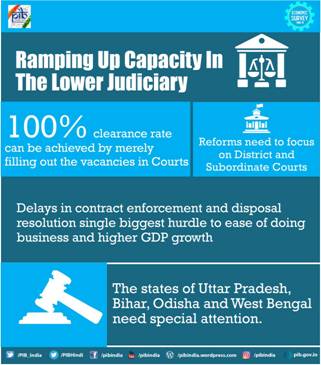The Union Minister for Finance and Corporate Affairs, Smt. Nirmala Sitharaman tabled the Economic Survey 2018-19 in Parliament today. Given the relationship between Economic Governance and the Rule of Law, in its Chapter titled “Ending Matsyanyaya: How To Ramp Up Capacity In The Lower Judiciary”, the Survey states that Contract enforcement remains the single biggest constraint to improve our Ease of Doing Business ranking. “Delays in contract enforcement and disposal resolution are arguably now the single biggest hurdle to the Ease of Doing Business in India”, says the Survey. “This is not surprising given the 3.5 crore cases pending in the judicial system. Much of the problem is concentrated in the District and Subordinate courts where 87.5 per cent of cases are pending” adds the Survey. Therefore, this segment must be the focus of reform, notes the document. The Survey points-out that major hurdle to economic growth and social well-being can be stabilized through a relatively small investment in the legal system.
Economic Survey 2018-2019 highlights the profound impact that the Government’s efforts of introducing the Insolvency and Bankruptcy Code and the adoption of the Goods and Services Tax, have had on improving Ease of Doing Business (EoDB) in India, with the Country being one of the biggest ‘improvers’ in the World Bank’s EoDB 2019, with its rank jumping to 77 from 142 in the last four years.

“Simulations of efficiency gains and additional judges needed to clear the backlog in five years, suggest that the numbers are large but achievable” states the document. The Survey concludes that given the potential economic and social multipliers of a well-functioning legal system, this may well be the best investment India can make. The Survey however notes that contrary to conventional belief, the problem is not insurmountable. The document suggests that a Case Clearance Rate of 100 per cent (i.e. zero accumulation) can be achieved with the addition of merely 2,279 judges in the lower courts, 93 in High Courts and only one in the Supreme Court, which is already within sanctioned strength and only needs filling of vacancies.
Further the document adds that the scenario analysis of efficiency gains needed to clear the backlog in five years suggest that the required productivity gains are ambitious, but achievable. As per the Survey, required productivity gains at full sanctioned strength of judges in lower courts is 24.5 per cent, 4.3 per cent in High Courts and 18 per cent in the Supreme Court. According to the data, the case type analysis reveals that the pendency of cases is highly skewed towards criminal cases in lower courts. “Criminal original suits contribute 64 per cent of the total pendency as of May 31, 2019 with a clearance rate of 85.3 per cent”. The Survey believes that a culture of Rule of Law must pervade as all of the governance and cannot be improved in silos. The document recommends additional judges need to specialize in these case types to speed up the disposal of such cases.
The Survey points-out that States of Uttar Pradesh, Bihar, Odisha and West Bengal need special attention, given their lower clearance rates. Hence, the Survey suggests that these States should be given priority in the appointment of additional judges.
For enhancing productivity in the judiciary, the Survey suggests: Increase number of working days; Establishment of Indian Courts and Tribunal Services to focus on the administrative aspects of the legal system; Deployment of Technology to improve efficiency of the courts, e.g. eCourts Mission Mode Project and the National Judicial Data Grid being rolled-out in phases by the Ministry of Law and Justice.
****************
DSM/RM/SBS/SC/ac